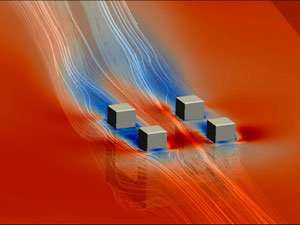Designing deep-sea oil rigs could be improved by simplified wave simulations

Evaluating the impact of waves on deep-sea oil rigs has been made easier by an A*STAR-developed computational technique that should increase the operational lifetime of floating platforms and make them cheaper to manufacture.
Offshore oil platforms and wind turbines conventionally rest securely on the seabed. But if they are to operate in deeper waters, floating structures are required. Given the enormous investment needed to build and position these platforms, it is essential that they can withstand waves, storms and even tsunami. Potential designs are typically tested by building a model and trialling it in a wave tank—but this is expensive, and results obtained under such controlled conditions are not always transferable out at sea.
Computer simulations provide a cheaper approach. The rapid development of high performance computers has made it possible to solve the complicated three-dimensional nonlinear equations that describe fluid flow around and through a complex arrangement of objects. But the calculations are time consuming, and engineers must often make a compromise between accuracy and efficiency. To address this trade-off, Xin Lu and co-workers from the A*STAR Institute of High Performance Computing developed a method that reduced computing time by building on a technique known as domain decomposition.
Their method divides the area to be simulated into subdomains in which different types of calculations are performed: a near field subdomain in which the viscous flow model is applied, and a far-field domain in which a model that calculates the system's potential energy is applied. The computational effort per subdomain is much smaller than the full domain, but coupling the subdomains is difficult. Lu and the team achieved this coupling by overlapping the regions in what they call buffer zones. "This overlapped zone technique eliminates the need for sub-iteration in each time step, thus speeding up the modeling," explains Lu.
The team use their overlapping domain decomposition technique to model the propagation of a solitary wave, to measure the impact of the wave on a partially submerged body and to recreate a wave as it breaks on a beach. "This new method is able to deliver comparable results in just half or even a third of the original computing time," says Lu. "And when optimized, the computing time is expected to be further reduced by 80 per cent."
More information: Xin Lu et al. An overlapping domain decomposition based near-far field coupling method for wave structure interaction simulations, Coastal Engineering (2017). DOI: 10.1016/j.coastaleng.2017.04.009




















